Kevan Manwaring's Blog: The Bardic Academic, page 25
October 7, 2018
#Sketchtember
DIARY OF A VIVA NINJA – DAY 11-12
Although this is tangential I thought I’d include it anyway. Last month I came up with a drawing challenge – one pencil sketch a day for 30 days – which I called #Sketchtember. It provided a gentle incentive to draw, which I find relaxing. And I did manage it most days, except when I was extremely busy/away from home with work. Despite these missed days, I still managed 30 sketches (plus extra, because I did a couple of ‘warm ups’ before the month began). I wanted to offer it as an example of the kind of micro-projects that make up a PhD – not sketching necessarily (although my transmedia approach did encompass that – see my research website www.thesecretcommonwealth.com). But a PhD is all about good project management and self-discipline. Setting yourself regular goals – short-, mid-, and long-term (and rewarding yourself when you complete them!). Focusing on a priority task first, then working your way down the list, basically – but ‘little and often’ is far better, (e.g. daily) than trying to do too much. To avoid being overwhelmed, or burning out, small, achievable tasks are better for the motivation. Recently, in preparing for my Viva, I’ve tried to focus on one key task each day. Something I can achieve in an hour or two. This stops the feeling of ‘never enough’. Yes, there is always more you can do, but zoom in on one thing at a time. Get that done. Then next day, when you’re fresh, start on the next on the list. It is important not to beat yourself up about ‘slippages’ – days off; days missed. Life happens. The main thing is to focus on what you have achieved. And now and then, (e.g. once a week) look back and take stock. You’ll be surprised by how far you have come, and how much you have done.
SKETCHTEMBER sketches by Kevan Manwaring September 2018
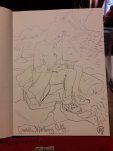
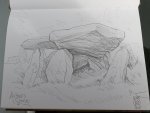


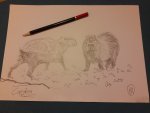
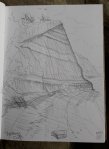
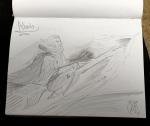

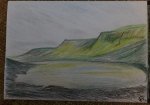

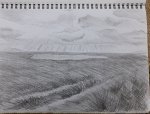
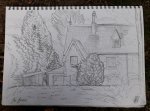


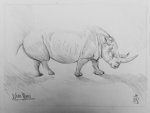
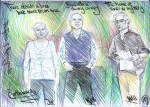

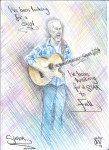
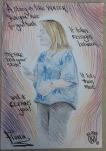



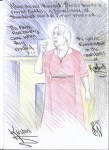




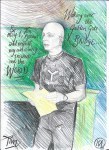
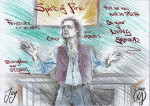

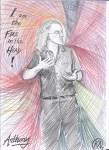

October 5, 2018
In a Nutshell
Diary of a Viva Ninja: Day 10
[image error]
Today I have been looking at introducing and summarising one’s thesis. One of the first questions the candidate is likely to be asked in a Viva is – ‘So what is it about?’ or words to that effect. Sometimes this is used as a good ‘warm-up’ question, to ease the student into the Viva, but also, critically, to assess whether the thesis is indeed their own unique work. Many students focus so much on the micro-detail that they sometimes come unstuck in this bigger, more obvious question. It is useful to have an ‘elevator pitch’ type response anyway, for those occasions when you may be asked about your research at a conference, or in less formal circumstances – the ‘BBQ speech’ as the Thesis Whisperer so wittily puts it. Much emphasis these days is on ‘widening access’ and academic brownie points are gained by being able to share one’s research with non-specialist audiences. This came up as a key theme on Monday when I co-hosted an Arts/Science showcase on Artificial Intelligence with a mathematics professor in the ‘Everybody’s Reading Festival 2018’, at a cool arts venue in Leicester (LCB Depot). We had a real cross-section in the audience – from the ‘lay’ to academics leading research into consciousness at De Montfort University. It was important to connect, to communicate, with them all. If one is only able to communicate with other specialist audiences within one’s own narrow field, then the research doesn’t really go very far – it becomes almost entropic (according to the 2nd law of thermodynamics). We have to be prepared (and able) to reach out beyond our particular bubble.
I’ve attempted an embryonic summary here – a first attempt. Not to be eligible for the 3MT competition (it is about 5 minutes, so I’ve failed the criteria already), but just to practise talking about my research. It felt like a useful exercise. See what you think. Does it communicate my research? Does it make you want to know more?
Discover the origins of the 3-Minute Thesis (3MT) at the University of Queensland here:
https://threeminutethesis.uq.edu.au/about
View winning examples here:
https://threeminutethesis.uq.edu.au/watch-3mt
Check out advice on preparing a 3-minute thesis here: https://thesiswhisperer.com/2010/07/01/how-to-sell-your-thesis-in-3-minutes-or-less/
October 4, 2018
By the Living Voice
Diary of a Viva Ninja: Day 9
[image error]
Beard Pullers by June Sheridan
Although the commonly accepted definition of the doctoral rite-of-passage, the ‘Viva Voce’, is an ‘oral examination’, the one that appeals most to me is ‘by the living voice’. As soon as I came across this I suddenly felt a quantum of reassurance – for I have made a lifetime’s study of the performance of bardic skills and development of the bardic tradition (2004; 2006; 2008; 2010; 2012; 2013; 2016; 2018). The Viva is conducted not within the oral tradition but within an extremely rigorous academic frame, of course, and it is important to understand that it is ‘a new form of high-level communication, [one for which] you need to gain some advanced rhetorical and performance skills’ (Murray, 2015: 2). Nevertheless, there are some interesting overlaps (eg variants of the ‘skills’ Murray mentions), and considering the Viva in this way, reframing it as a bardic endeavour, means I am not sticking my neck out, but drawing upon years of informed creative-practice and research.
Forms of oral examination have been around for a long time, most famously in the Socratic Method of question-and-answer. Here the questioner hopes to catch the recipient out, sometimes by performing a disingenuous ignorance: Socratic Irony. My preference is for the less hierarchical and mutually empowering colloquy one comes across in the Celtic tradition. The finest example of this is known as ‘The Colloquy of the Two Sages’ in which the young budding bard, Nede, is challenged by a senior bard, Fercheirtne, whose chair he wishes to claim (as the descendent of the previous incumbent, his father). Through an intense series of ritualised questioning, Nede (wearing a mock beard of grass) has to defend his claim to the chair. His examiner ‘pulls his beard’, that is tests his knowledge and the authenticity of his claim. Critically, the questioner’s role here is not necessarily antagonistic. Fercheirtne is questioned in return by Nede and his answers seek to ‘outbard’ the challenger, like some Iron Age rap battle. But in the process, both ‘combatants’ display their skill and their answers encode great wisdom and poetry power for future bards to learn from and even perform (as Williamson memorably does in an epic feat of bardic skill). The outcome of this is for the young bard to become, eventually, an ollamh, a Doctor of Verse – so in it we can see a direct analogy to the Viva. A translation of it by no less than Robin Williamson (Incredible String Band; Honorary Bard of OBOD, etc) graces the end-pages of my Bardic Handbook. Here is a taster:
The Colloquy of the Two Sages (extract)
A question, o young man of learning, what art do you practise?
to which Nede replied:
not hard to answer
I bring blush to face
and spirit to flesh
I practise fear’s erasure
and tumescence of impudence
metre’s nurture
honour’s venture
and wisdom’s wooing
I shape beauty to human mouths
Give wings to insight
I make naked the word
In small space I have foregathered
The cattle of cognizance
The stream of science
The totality of teaching
The captivation of kings
And the legacy of legends.
And you my elder, what are do you practise?
to which Fercheirtne replied:
not hard to answer
sifting of streams for gold of wisdom
lulling of hearts from the fires of anger
captaincy of words
excellency of skill
putting feathers in kings’ pillows
I have acquired a thirst that would drain the Boyne
I am a maker of shields and wounds
a slicer of pure air
an architect of thought
I can say much with few words
I can sing the long miles of great heroes’ lives
I am a jeweller of the heart.
(From Irish tradition, translation by Robin Williamson, The Bardic Handbook, 2006).
Apart from the sheer beauty of the poetry, the colloquy teaches us to hone our own powers of communication to their highest level, to love language and debate, and to (hopefully) savour the experience of discussing one’s major research project with highly-skilled and experienced academics. To have such a level of critical attention should be seen as not a painful, compulsory final hurdle but as a privilege. After all, it is what you have worked towards for so long. It is your ‘opening night’, academically. First night nerves are inevitable, but rehearsal and classic performance techniques can help mitigate those nerves.
In performance the more relaxed one becomes in front of an audience, the easier it gets – certainly, the more likely it is for the ‘awen’, (Welsh, f. noun: inspiration) to flow. Nothing can replicate ‘live experience’. In the folk world it is a truism that you need to ‘fail’ in front of a real audience with new song, then ‘fail better’ next time.
The aim is, through practice, to become habituated to the rarefied climate of high academic discourse, to a sustained critical debate:
‘Students have to understand the components of communicative strategies, customize them for their own examinations and practise them well in advance, to the point where the strategies have become part of their rhetorical repertoire.’ (Murray, 2015: 90)
And so … practise, practise, practise!
Works by Kevan Manwaring on the bardic tradition:
Fire in the Head: creative process in the Celtic diaspora, Awen 2004
The Bardic Handbook: the complete manual for the 21st Century bard, Gothic Image, 2006
The Book of the Bardic Chair, RJ Stewart Books 2008
The Way of Awen: journey of a bard, O Books, 2010
Oxfordshire Folk Tales, The History Press, 2012
Northamptonshire Folk Tales, The History Press, 2013
Ballad Tales: an anthology of British ballads retold (ed.), The History Press, 2016
Silver Branch: bardic poems and letters to a young bard, Awen 2018
Other works cited
Murray, R. (2015) How to Survive a Viva: defending a thesis in an oral examination, Open University Press
Behold, the Shining Brow!
My latest collection features a series of practical essays on the bardic craft – Speak Likes Rain: letters to a young bard – full of useful advice for performance poets of all stripes.
By Kevan Manwaring (Lughnasadh 2018)
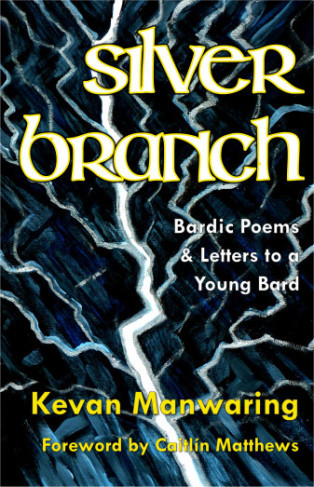 As a mode of enquiry for a creative practitioner interested in the bardic tradition, my poetry has, for over a quarter of a century, been a sustained commitment to what I eventually called the ‘Way of Awen’ (from 2004). I began to write poetry in 1991, inspired by a trip hitchhiking around Ireland – a young man interested in Celtic legends, with a nascent inclination towards Paganism. I met my ‘muse’ figure in a park in Galway and corresponded with her, writing her long letters (in those low-fi days before the internet became ubiquitous) and my first attempts at poetry. I wove in magical symbolism, inspired by W.B. Yeats, Dion Fortune, William Blake, and Jim Morrison, among others. I started going to ‘open mike’ events and inflicting my poetry on others. I quickly realised that reading from a text can create a barrier between the…
As a mode of enquiry for a creative practitioner interested in the bardic tradition, my poetry has, for over a quarter of a century, been a sustained commitment to what I eventually called the ‘Way of Awen’ (from 2004). I began to write poetry in 1991, inspired by a trip hitchhiking around Ireland – a young man interested in Celtic legends, with a nascent inclination towards Paganism. I met my ‘muse’ figure in a park in Galway and corresponded with her, writing her long letters (in those low-fi days before the internet became ubiquitous) and my first attempts at poetry. I wove in magical symbolism, inspired by W.B. Yeats, Dion Fortune, William Blake, and Jim Morrison, among others. I started going to ‘open mike’ events and inflicting my poetry on others. I quickly realised that reading from a text can create a barrier between the…
View original post 378 more words
October 3, 2018
Diary of a Viva Ninja: Day 5-8
Real Life: challenges or opportunities?
[image error]
Every situation is a potential training or practice opportunity.
I’ve been unable to blog the last few days due to being intensely busy: five days of work which took me from Gloucestershire to Somerset, Bath to Heathrow, Wroughton to Northampton, to Oxford, Leicester and Stratford-upon-Avon, before finally back to Stroud: leading a batch of bardic tours (my main source of additional income, which have enabled me to pay my PhD fees these last four years); running a writing workshop; and co-hosting an Arts/Science showcase in the Everybody’s Reading Festival. It’s been an exhausting time, especially with the travelling – but that’s all part of the reality and challenge of completing a PhD for most of us. Real life doesn’t stop happening. As John Lennon said: ‘Life is what happens while you’re busy making other plans’, or to paraphrase, it’s what happens while you’re carefully planning and preparing for your Viva!
I have been making good progress, but all of that went out of the window since Friday. But now I can come up for air and continue – and things aren’t so bad. I am more or less on schedule, and most importantly feel like I’ve ‘got my head’ around the whole Viva process and refamiliarised myself with my thesis (critical commentary and novel). I’ve made copious notes, and read all the relevant material. I’ve drafted a list of questions – which I extended today with ‘Easy’, ‘Nightmare’ and ‘General’ questions. Now the priority really is to just keep practising. It is very easy to find Displacement Activities rather than face the cold, sobering reality of the forthcoming Viva (now imminent for me – at the end of this month). But as Polonius from Hamlet said: ‘Procrastination is the thief of time!’ It is easier to just get stuck in. Being rested, fed, refreshed, etc, really helps with this. Eating well, exercising, and getting a good night’s sleep is just as important (if not more so) than speed-reading a stack of books. However, I am finding identifying and reading relevant literature really helpful – especially critical works that will help maintain an ‘academic consciousness’ (and provide useful theoretical underpinning too boot). At the same time having something else to read when you’re relaxing is important too. You can’t stay switched on all the time. Reading an excellent novel is just as vital in my subject-area and discipline as non-fiction critical works. And over the last five days I have used other essential Viva skills: presenting in front of diverse audiences; sustaining a high-level discussion and defending my ideas in the AI showcase; managing complexity, and unpredictable, stressful circumstances. Life, even in its distractions, can provide ‘training experiences’.
September 30, 2018
Diary of a Viva Ninja: Day 4
Staying the distance. Me on High Cup Nick, on the Pennine Way. July 2018
Undertaking a PhD is a long-haul and to complete the 3-4 years of research one of the key qualities you need is stamina: staying power; tenacity – call it what you like. As long as it gets the job done. I’ve honed my stamina through by running and long-distance walking – because both of these requires tremendous mental (as well as physical) stamina. Each summer I’ve walked a long distance path, starting in 2014 with Hadrian’s Wall (84 miles) and increasing the distance each year: 2015: West Highland Way (96 miles); 2016: Offa’s Dyke (177 ml); 2017: Southern Upland Way (212 ml); and this year, the Pennine Way (255 miles). Even those these are my vacations (designed for R&R!) and, coming at the end of term, a form of ‘academic detox’ (post-exam marking period etc), each time I’ve tried to push myself a little bit further. This last one in particular, falling as it did straight after I submitted my 80,000 word Thesis (plus 75,000 word Appendices) ended up being not just ‘the Great Escape’ (by that point, after months of intense effort I really needed to cut loose) but also a kind of extended metaphor of the PhD journey. This was not something I thought about a lot until the final day, but the trek did seem to neatly break down into my four year experience, with each fifty miles representing a year and its landmarks: Year 1 – research, 1st draft; Year 2 – more research, 2nd draft; Year 3 – consolidation of research, 3rd draft; Year 4 – commentary and editing. But the ‘crunch’ time came, appropriately on the last day of my walk when I had to walk 26 miles, over 7 peaks straddling the English-Scottish border, with a full forty pound pack. I worked towards this – (extending the daily distance, resting, planning, etc), and by that point, I was ready to really push myself, as I didn’t have to hold anything back. There were about a dozen of us roughly walking the whole route over the same 2-3 week period, but everyone else broke the last day, by either having the guest house pick them up and drop them back the next morning, or by staying over in one of the two mountain huts. But I decided to go for it. It is interesting to push oneself now and then, to see what you can accomplish, and to see how you can cope. What was really resonant about this last day was – I saw it as a micro-metaphor for the Viva. By Byrness, the penultimate stop on the way, it really feels liked you’ve pretty much nailed the walk – a bit like the feeling of submission – but oh no, the big push is yet to come. I awoke at 4am in my tiny bivvy-shelter and was on my way by 5am. I saw the sunrise as I breached the brow of Byrness Knowe; and by 9am I had reached Ravens Knowe – which had spectacular views over the Scottish Borders. Riding on adrenalin I pushed myself to reach the summit (highest point of the walk) by 11am – 13 miles I had broken the back of the walk, and uncannily at the very moment I reached Windy Ridge I received an email notification telling me my thesis had been sent to the examiners (the Doctoral College take a while to process things, and it was huge relief to know it had been sent off). Reaching that summit felt like the day of the viva itself – a massive effort to prepare, to reach it; and then the almost vertiginous feeling of achieving it. I savoured the well-earned view as I ate my sandwiches and sipped some precious water. But then, critically, there was still an exhausting 12.5 miles to go, over several more peaks, with blistered feet and aching limbs – and this I saw as a sobering metaphor for: revisions (minor or major). It was a visceral, embodied way of preparing myself mentally for that extra effort. It is incautious to assume the Viva will be the end: it may just be the ‘beginning of the end’. That is the key thing to bear in mind. The Viva is ‘Windy Ridge’ (13 miles in); not Kirk Yetholm (the end of the 250+ miles of the Pennine Way). That’s the critical difference. Basically, don’t peak too soon. Save something in reserve for that final effort, if it is required (to undertake major or minor revisions, etc). Those last 12.5 miles were a real challenge as fatigue kicked in (cumulative, from 17 days of serious hiking), the temperature increased, water ran low, and blisters go worse. But I did it. Walking into Kirk Yetholm, to be greeted (unexpectedly) by the cheers of my fellow walkers sitting outside the Borders Hotel, was one of the most satisfying things I’ve ever done. I had accomplished what I had set out to do – by sheer determination and grit. Thousands of people finish the Pennine Way every year (although only a fraction do it all in one go), and many achieve their doctorates too – but this was my accomplishment, my day. And it had taught me a valuable lesson about ‘keeping something in reserve’ for that post-Viva final push, just in case it is needed. By succeeding in completing that last epic day I felt encouraged that, if it came down to it, I would be mentally prepared for whatever the examiners decide. They may say: ‘Congratulations! You have reached the finishing line!’ or they may say: ‘You have passed! But … you have another three or six months of effort still to do!’ Of course there could be other outcomes too. But walking a long-distance route in extreme conditions (a heatwave in my case, with fires on the moors, etc) inculcates resilience, and I will be ready.
September 28, 2018
Diary of a Viva Ninja: Day 3
Calm the mind. Relax the body. K. Manwaring 2018
One of the key strategies to bear in mind during all this preparation is: rest and relaxation. It is easy to become overwhelmed with the sheer amount of information you have to bear in mind: your entire thesis in your short-term memory, all the advice, all the logistics. The preparation seems endless and insurmountable. And yet you have completed and submitted your actual thesis – against all the slings and arrows of the last three to four years. That in itself is a major achievement, and shows you can shape, you can finish, you can deliver. Yet to be burnt out is no good to anyone – certainly not the optimum state to be entering a viva. And so daily ‘time outs’ are essential. They are just as important as regular reviewing of notes and relevant literature.
I try to factor in at least one (usually two or three) of the following into my daily schedule:
A run (I prefer off-road, up on the hills or amongst the trees).
A walk, perhaps into town – but certainly outdoors, in the sunlight (hopefully) sucking in some fresh air into my lungs, perhaps maybe getting a hit of ‘forest therapy’.
A swim.
Sitting in the garden.
Cat-stroking.
Reading (non-specialist literature).
Watching a TV show or a film.
Listening to music.
Baking.
Drawing.
Fire-gazing.
Yesterday was a good example of that. It was a gloriously sunny, warm, autumnal day. I had a choice-point around 5pm. Either push on with my prep, or go for a wild swim. I chose the latter and I’m so glad I did. The literally immersive experience brought me back into my body, into the ‘here and now’. The bracing water got the blood circulating, the endorphins flowing. It felt great. I said hello to a few ducks. Afterwards I went and sat by a spring underneath a yew tree. A little Shinto-like shrine had been made there. The sound of the trickling water was very relaxing. Sitting underneath the canopy of trees I felt calm, safe, content. Gazing into the small pool I let my thoughts lightly consider the PhD. Just being away from my study gave me a perspective on it. I gleaned some insights. The key concepts were:
Clarity
Depth
Reflection
Peacefulness
All these are good things to ‘carry’ with you into the viva. I can picture the pool in the forest now and immediately feel a sense of calm. In the stress of the cross-questioning from the examiners I may use it as a strategy to remain calm. From that place of calm stillness, lucidity comes. This ‘cognitive set’ is far more useful than trying to remember a million things. Although preparation is essential – familiarisation with one’s thesis; practicing Q&A in a high-level academic discourse; continual updating one’s knowledge and awareness of the specialist field, etc – perhaps ultimately a clear head (and a rested body) will serve you better in the long run. Finding one’s centre, an equipoise, will enable you to cope with not only the ‘known knowns’ (things that you will expect to happen in the viva such as the general format and types of outcome) and the ‘known unknowns’ (the specific questions asked; mood and behaviour of the examiners on the day; reaction to your thesis and answers); but also the ‘unknown unknowns’. Having a calm but alert state of mind will enable you to be flexible in the face of the unexpected, and to cope with whatever circumstances throw at you.
See you tomorrow, Shadow-huggers. Until then, let the ripples of your mind calm. Be at peace.
September 27, 2018
Diary of a Viva Ninja: Day 2
So I’ve finally got a date for my Mock-Viva – mid-October (it’s always busy at the start of term, and my fantastic supervisor has a lot on his plate). A chance to rehearse the viva experience in front of a couple of academics asking questions, having a date in place for my MV makes the whole thing that little bit closer and more real.
Because I believe you can never be over-prepared I now have in place:
Mock-Mock – with writer friends in Stroud roleplaying the examiners and chair. A chance for them to mock me!
Mock-Viva – on campus at the University of Leicester with a couple of academics.
Viva – the big day! With internal and external examiners, possibly a Chair, and even your supervisor in attendance (although they are not allowed to speak).
Although one cannot pre-empt every question, and have off pat every answer (indeed one does not want to sound like answers are memorised or on ‘auto-cue’) it is wise to start practicing articulating one’s research and being able to defend it in a rigorous discussion.
So, with the help of my Viva cards, that’s what I’m going to start doing.
Meanwhile, here are the tips from my doctorate friends:
Right at the start of the Viva, greet the examiners/chair, shake their hands, and thank them for giving you their time and expertise.
Remember you are not ‘under attack’ – do not become defensive. The examiners want to engage you in intellectual discussion about your research. They have spent time and effort reading through your thesis. Appreciate the skill of their questions.
Take plenty of notes.
Remember the examiners are on your side.
Be confident!
My other Dr friend added: https://port.sas.ac.uk/mod/page/view....
The advice in a nutshell from ‘The Viva as an experience’ was:
Be yourself.
Have confidence in your own work.
Take your time.
Reflect and answer thoughtfully.
And remember – this is a chance to present your work. See it as a positive experience.
Until tomorrow, Shadow-huggers! Walk with the lightness of a grasshopper on a blade of grass.
September 26, 2018
Diary of a Viva Ninja: Day 1
In just over a month’s time I will have my PhD viva – 2 hours (more or less) to defend 4 years (6 years, including initial notes and plans) of work. So, a lot is at stake (for me), therefore I am doing all I can to prepare for it. There is a lot of advice out there, some of it contradictory or ambiguous, and so to help ‘narrow the field’ and filter things down to what is useful, and what it is actually like to undergo a Viva (in the UK) I will endeavour to blog my experiences here, for what it’s worth. If nothing else, it’ll keep me sane as I take stock on my day and document what I have done, and hopefully the progress I have made.
I submitted the end of June 2018. After having a recommended break, stepping away from it for the summer, after an intensive end-game of endless editing, etc, as I wrestled my creative and critical components into shape, I finally turned back to it at the start of this month.
Following the most useful practical advice I have:
Re-read my whole thesis (critical component, so far) summarising each chapter.
I have compiled a list of possible questions.
I have arranged a ‘mock-mock’ with friends, which will help me practice articulating answers to possible questions (awaiting date of mock viva).
I have familiarised myself with the work of my internal and external examiners, tracking down their PhD theses, recent articles, and published prose fiction.
I have continued to stay abreast of developments in my field.
What I have found useful has been establishing a daily routine in the lead-up to the big day (let’s call it V-Day). In the morning I work on my current novel-in-progress (I’m a writer, first and foremost; and in my thesis I argue for the validity of practice-based research). In the afternoon I turn to my specific Viva-prep tasks – usually a combination of:
summarising chapters (working through novel).
making notes on questions and (crucially) answers.
reading relevant literature (viva stuff to subject-specific).
refreshing my familiarity with a glossary of key terms.
checking out blogs and other online resources (e.g. videos).
Yesterday I made some Viva Cards, with questions written on them. I also did a Skills Audit (in terms of oral presentation – for the viva has been called ‘a new form of communication’ Rowena Murray). I requested clarification on my institutions code of regulations and practices regarding the Viva (and received a reply today with links to the relevant resources – I’d already found these, but wanted to make sure I hadn’t missed anything).
It is advised to not only keep abreast of developments and literature in the field, but also to consider possible outlets for one’s research: publication. Therefore I have made a list of potential journals for versions of chapter-articles from the critical commentary. I have at least three lined up – all top peer-reviewed journals. As I have been published by one of them already (Writing in Practice) I am positive I’ll get something accepted somewhere at some point!
Today, I reviewed the slides from a ‘Preparing for your Viva’ workshop I took part in back in early March (via an online conference as it was wintry). I’ve undertaken numerous training activities with the Doctoral College at my university (Leicester). They have been indispensable in helping me through the various stages of my PhD. I must have done about a 100 such training events since I registered in 2014 – from Induction through to Submission. My philosophy is: if you’re paying for it, make the most of it.
I drafted and sent an abstract for a subject-specific conference (Great Writing 2019). Examiners want to know your willingness and capability to step into the role of a fully-fledged academic, contributing to the field with continuing research. I have a whole second-phase of critical outputs planned, advised by my supervisor and other academics to stagger my research, and drip-feed my key findings in various articles and papers. An article is planned for Folklore, and a critical edition ultimately, pending funding and possible research assistance – anyway, stuff to keep me out of mischief for a few years.
One of the most useful things I did last week was to contact a couple of friends who had received their doctorates, to ask for their perspective on the whole experience. I had a very useful and encouraging conversation with one of them, who kindly offered me his time and expertise. These first-hand accounts help to counteract the mystique that seems to coalesce around vivas. Anybody think it was like joining the Freemasons!
Fortunately, Viva Ninja is here to cut through the apron of secrecy (with one trouser leg rolled up).
Until tomorrow, Shadow-huggers.
Murray, R. (2015) How to Survive Your Viva: defending a thesis in an oral examination. 3rd Ed. Maidenhead, Berks: Open University Press.




